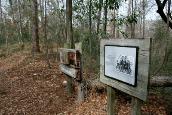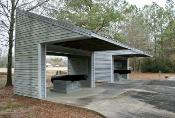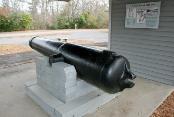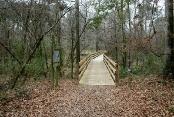Siege & Battle of Port Hudson - Jackson, Louisiana
| Battle of Port Hudson, Louisiana A cannon aims out over Port Hudson State Historic Site, where Confederate and Union troops fought the longest siege of the Civil War. |
Battle of Port Hudson
Miles of original trenches and
earthworks can still be found
at the Port Hudson battlefield
in Louisiana.
Miles of original trenches and
earthworks can still be found
at the Port Hudson battlefield
in Louisiana.
Original Confederate Flag
Two of the original Southern
flags that flew over Port
Hudson during the siege are
on display in the museum.
Two of the original Southern
flags that flew over Port
Hudson during the siege are
on display in the museum.
Site of a Union Battery
An interpretive panel near the
museum marks the site of a
Union battery that bombarded
Confederate positions.
An interpretive panel near the
museum marks the site of a
Union battery that bombarded
Confederate positions.
Siege & Battle of Port Hudson - Jackson, Louisiana
Port Hudson State Historic Site
Alabama-Arkansas Redoubt
Well-preserved earthworks
mark a position held by men
from Arkansas and Alabama
during the siege.
Well-preserved earthworks
mark a position held by men
from Arkansas and Alabama
during the siege.
| Copyright 2011, 2013 & 2014 by Dale Cox All rights reserved. Last Update: May 21, 2014 |
Battle of Mobile Bay - Alabama
Arkansas Post National Memorial - Arkansas
Pea Ridge National Military Park - Arkansas
Poison Spring Battlefield State Park - Arkansas
Natural Bridge Battlefield State Park - Florida
Grand Gulf Military Monument - Mississippi
Raymond Battlefield Historic Site - Mississippi
Vicksburg National Military Park - Mississippi
Shiloh National Military Park - Tennessee
Arkansas Post National Memorial - Arkansas
Pea Ridge National Military Park - Arkansas
Poison Spring Battlefield State Park - Arkansas
Natural Bridge Battlefield State Park - Florida
Grand Gulf Military Monument - Mississippi
Raymond Battlefield Historic Site - Mississippi
Vicksburg National Military Park - Mississippi
Shiloh National Military Park - Tennessee
Located atop high bluffs overlooking an old
channel of the Mississippi River, Port
Hudson State Historic Site preserves 909
acres of the scene of the 1863 Siege and
Battle of Port Hudson, Louisiana.
The battlefield entrance is located on U.S. 61,
20 miles north of downtown Baton Rouge
and 12 miles south of St. Francisville. The
park preserves original fortifications, Union
battery positions and the scene of heavy
fighting during the battle.
The grand Union strategy of the Civil War
was the "Anaconda Plan" developed by Gen.
Winfield Scott in 1861. By imposing a naval
blockade of the Southern coastline and then
retaking the Mississippi River, Scott's plan
would eventually strangle the Confederacy to
death. By early 1862, the blockade was in
effect and attention turned to the Mississippi
River.
The Union Navy stormed passed the forts
below New Orleans in April of 1862 and
warships soon anchored off Baton Rouge as
well. Confederate forces attacked the latter
city on August 5, 1862, during the Battle of
Baton Rouge. The attack failed, however, and
the Southern troops withdrew up the river to
Port Hudson.
With New Orleans and Baton Rouge in Union
hands, the situation on the Mississippi was
critical for the Confederacy. Up the river,
VIcksburg, Mississippi had been strongly
fortified, but a similar choke point was
needed to bloke Federal ships from going up
the Mississippi and into the vital Red River
as well. Port Hudson, located atop high bluffs
overlooking a sharp bend of the river, proved
to be the ideal location for a second citadel.
Beginning on August 15, 1862, Confederate
forces planted a series of river batteries
armed with heavy cannon along the bluff and
then constructed a 4 1/2 mile long line of
breastworks and earthen forts to protect the
rear of the position from land attacks.
The strength of the unfinished position was
first tested on September 7, 1862, when
Commander David Dixon Porter attacked
Port Hudson with the U.S.S. Essex and the
U.S.S. Anglo-American. The Confederate
gunners, some of whom came from the
famed ironclad C.S.S. Arkansas after that
ship was destroyed at Baton Rouge, used
plunging fire from the bluffs to pound the
Union warships. The Essex alone suffered
14hits and the naval attack failed.
The task of taking Port Hudson now fell to
Maj. Gen. Nathaniel P. Banks, a political
appointee from Massachusetts. He moved
north from New Orleans to Baton Rouge in
early 1863. Recognizing that a crisis was
building, the Confederate high command
sent Maj. Gen. Franklin Gardner to take
command at Port Hudson. A professional
soldier and hard-fighting commander, he
proved to be an excellent choice.
Gardner immediately set to improving the
defenses of Port Hudson and the works
there became a masterpiece of military
engineering. He used the high bluffs and
deep ravines surrounding the town in the
design of his lines and focused on creating
clear fields of fire for his cannon.
The Union Navy again tested the batteries of
Port Hudson on the night of March 14, 1863.
Commanded by Admiral David G. Farragut, a
line of warships and gunboats moved within
range of the Confederate positions shortly
before midnight.
The Southern forces now had twenty pieces
of artillery aimed out over the river and they
opened a devastating fire on Farragut's
ships. Two vessels, the admiral's flagship
U.S.S. Hartford and the U.S.S. Albatross, got
through, but the others did not. The U.S.S.
Mississippi, a steam frigate, was demolished
by the Confederate batteries and went up in
an explosion so powerful that it could be
heard as far away New Orleans.
Rather than moving immediately on Port
Hudson, Gen. Banks instead tried to bypass
it but was stymied by lack of transportation.
This gave the Confederate garrison even
more time to prepare their defenses and
stockpile munitions and provisions.
Gen. Ulysses S. Grant, meanwhile, had
begun his move on Vicksburg. It was now
critical that Banks launch a similar attack on
Port Hudson. Part of the Union army moved
north from Baton Rouge while the rest came
down the Red River by boat. The advance
from the south was led by bridge-builders
from the 3rd Louisiana Native Guards, an
African-American regiment.
Fighting broke out four miles east of Port
Hudson at the Battle of Plains Store on May
21, 1863, Six hundred Confederates held off
thousands of Union troops for more than one
hour before falling back into the main citadel.
The Union army followed.
The second wing of the army, accompanied
by General Banks himself, came down the
Red and Mississippi Rivers from the
Atchafalaya and landed at Bayou Sara near
St. Francisville. Once ashore, these soldiers
pushed south to complete the encirclement
of Port Hudson.
Harassed by Confederate cavalry, it took
Banks five days to get his army fully into
position for his first attack. Gardner and his
men spent the time strengthening their
defenses, extending their lines and moving
some of their heavy cannon from the river
batteries into the fortifications that faced the
Union army.
These forts soon earned nicknames like
"Priest's Cap" and Fort Desperate. They were
located atop ridges surrounded by a labyrinth
of ravines, creeks and woods.
channel of the Mississippi River, Port
Hudson State Historic Site preserves 909
acres of the scene of the 1863 Siege and
Battle of Port Hudson, Louisiana.
The battlefield entrance is located on U.S. 61,
20 miles north of downtown Baton Rouge
and 12 miles south of St. Francisville. The
park preserves original fortifications, Union
battery positions and the scene of heavy
fighting during the battle.
The grand Union strategy of the Civil War
was the "Anaconda Plan" developed by Gen.
Winfield Scott in 1861. By imposing a naval
blockade of the Southern coastline and then
retaking the Mississippi River, Scott's plan
would eventually strangle the Confederacy to
death. By early 1862, the blockade was in
effect and attention turned to the Mississippi
River.
The Union Navy stormed passed the forts
below New Orleans in April of 1862 and
warships soon anchored off Baton Rouge as
well. Confederate forces attacked the latter
city on August 5, 1862, during the Battle of
Baton Rouge. The attack failed, however, and
the Southern troops withdrew up the river to
Port Hudson.
With New Orleans and Baton Rouge in Union
hands, the situation on the Mississippi was
critical for the Confederacy. Up the river,
VIcksburg, Mississippi had been strongly
fortified, but a similar choke point was
needed to bloke Federal ships from going up
the Mississippi and into the vital Red River
as well. Port Hudson, located atop high bluffs
overlooking a sharp bend of the river, proved
to be the ideal location for a second citadel.
Beginning on August 15, 1862, Confederate
forces planted a series of river batteries
armed with heavy cannon along the bluff and
then constructed a 4 1/2 mile long line of
breastworks and earthen forts to protect the
rear of the position from land attacks.
The strength of the unfinished position was
first tested on September 7, 1862, when
Commander David Dixon Porter attacked
Port Hudson with the U.S.S. Essex and the
U.S.S. Anglo-American. The Confederate
gunners, some of whom came from the
famed ironclad C.S.S. Arkansas after that
ship was destroyed at Baton Rouge, used
plunging fire from the bluffs to pound the
Union warships. The Essex alone suffered
14hits and the naval attack failed.
The task of taking Port Hudson now fell to
Maj. Gen. Nathaniel P. Banks, a political
appointee from Massachusetts. He moved
north from New Orleans to Baton Rouge in
early 1863. Recognizing that a crisis was
building, the Confederate high command
sent Maj. Gen. Franklin Gardner to take
command at Port Hudson. A professional
soldier and hard-fighting commander, he
proved to be an excellent choice.
Gardner immediately set to improving the
defenses of Port Hudson and the works
there became a masterpiece of military
engineering. He used the high bluffs and
deep ravines surrounding the town in the
design of his lines and focused on creating
clear fields of fire for his cannon.
The Union Navy again tested the batteries of
Port Hudson on the night of March 14, 1863.
Commanded by Admiral David G. Farragut, a
line of warships and gunboats moved within
range of the Confederate positions shortly
before midnight.
The Southern forces now had twenty pieces
of artillery aimed out over the river and they
opened a devastating fire on Farragut's
ships. Two vessels, the admiral's flagship
U.S.S. Hartford and the U.S.S. Albatross, got
through, but the others did not. The U.S.S.
Mississippi, a steam frigate, was demolished
by the Confederate batteries and went up in
an explosion so powerful that it could be
heard as far away New Orleans.
Rather than moving immediately on Port
Hudson, Gen. Banks instead tried to bypass
it but was stymied by lack of transportation.
This gave the Confederate garrison even
more time to prepare their defenses and
stockpile munitions and provisions.
Gen. Ulysses S. Grant, meanwhile, had
begun his move on Vicksburg. It was now
critical that Banks launch a similar attack on
Port Hudson. Part of the Union army moved
north from Baton Rouge while the rest came
down the Red River by boat. The advance
from the south was led by bridge-builders
from the 3rd Louisiana Native Guards, an
African-American regiment.
Fighting broke out four miles east of Port
Hudson at the Battle of Plains Store on May
21, 1863, Six hundred Confederates held off
thousands of Union troops for more than one
hour before falling back into the main citadel.
The Union army followed.
The second wing of the army, accompanied
by General Banks himself, came down the
Red and Mississippi Rivers from the
Atchafalaya and landed at Bayou Sara near
St. Francisville. Once ashore, these soldiers
pushed south to complete the encirclement
of Port Hudson.
Harassed by Confederate cavalry, it took
Banks five days to get his army fully into
position for his first attack. Gardner and his
men spent the time strengthening their
defenses, extending their lines and moving
some of their heavy cannon from the river
batteries into the fortifications that faced the
Union army.
These forts soon earned nicknames like
"Priest's Cap" and Fort Desperate. They were
located atop ridges surrounded by a labyrinth
of ravines, creeks and woods.





Against the advice of some of his more
experienced generals, Banks decided to
storm Port Hudson. He had 30,000 men to
oppose the 4,000 commanded by Gardner
and felt he could easily force his way through
the Confederate defenses and take the
position.
The artillery announced the attack by firing on
the beleaguered Confederates from all
directions on the morning of May 27, 1863.
The Southern cannon responded with a fury
of fire but then slowed in order to conserve
ammunition.
After a heavy bombardment, thousands of
Union soldiers attacked straight into an area
of deep ravines fronting Gardner's northern
defenses. The rugged terrain broke up the
attacks and funneled the men into a position
ringed on three sides by Southern troops.
The assault degenerated into a blood bath.
With the attack stalemated by 10 a.m., the 1st
and 3rd Louisiana Native Guards were
ordered to attack near the point where the
northern end of the Confederate line
intersected with the Mississippi River. They
fought courageously, but were driven back.
30 pieces of Union artillery bombarded the
Confederate earthworks on the east side of
Port Hudson and Brig. Gen. T.W. Sherman's
Division then attacked. Like the assault on
the northern defenses, the attack on the east
failed. The Union soldiers charged into brutal
Confederate fire and the name of Slaughter's
Plantation, where some of the attacking
forces formed, gained new meaning.
By the time Banks requested a truce the next
morning, nearly 2,000 Union soldiers lay
dead or wounded. The victory shouts of
Gardner's Confederates, who had lost only
235 men, echoed over the battlefield.
General Banks then began regular siege
operations against Port Hudson. The
Confederates took advantage of delay to
strengthen their position more. They even
collected spent Union bullets from the
earthworks and sewed them into canister
loads to fire back at the Federals in the next
attack. They did not have to wait long.
On June 13, 1863, Gen. Banks ordered a
one-hour bombardment of the Confederate
lines. He then sent in a demand that Gardner
surrender the works. The Southern general
refused and the Union troops surged forward
at 3:30 the next morning.
The attack was poorly planned and disrupted
by early morning fog. Three assaults were
driven back and by the time the smoke
cleared, Banks had suffered another 1,792
casualties. Only 47 Confederates were killed
or wounded. Another assault had ended in
bloody disaster for the Union army.
The siege went on until July 9, 1863. It was
not until after he learned of the July 4th fall of
Vicksburg that Gardner decided that the
courageous effort of his men to hold Port
Hudson no longer served a purpose. The
Confederates by then were eating rats and
mules. The white flag went up and the
longest siege in American history finally
came to an end.
An estimated 10,000 Union soldiers were
killed, wounded or died from illness at Port
Hudson. The Confederates lost 750, nearly
half of whom died from sickness.
Visitors can now tour key areas of the
battlefield at Port Hudson State Historic Site.
The park features preserved earthworks,
exhibits, more than 6 miles of trails,
overlooks, an outstanding museum and a
picnic area. The museum offers a driving
tour map of sites outside the park that
include the river batteries, Port Hudson
National Cemetery and the Plains Store
battlefield.
The park is open Tuesday through Saturday
(closed Sunday and Monday) from 9 a.m. to 5
p.m. Cost of admission is $4 per person.
Seniors and children under 12 admitted free.
Port Hudson State Historic Site is at 236
Hwy 61, Jackson, Louisiana. The park is 20
miles north of Baton Rouge and 12 miles
south of St. Francisville.
Please click here to visit the official website
for directions and more information.
experienced generals, Banks decided to
storm Port Hudson. He had 30,000 men to
oppose the 4,000 commanded by Gardner
and felt he could easily force his way through
the Confederate defenses and take the
position.
The artillery announced the attack by firing on
the beleaguered Confederates from all
directions on the morning of May 27, 1863.
The Southern cannon responded with a fury
of fire but then slowed in order to conserve
ammunition.
After a heavy bombardment, thousands of
Union soldiers attacked straight into an area
of deep ravines fronting Gardner's northern
defenses. The rugged terrain broke up the
attacks and funneled the men into a position
ringed on three sides by Southern troops.
The assault degenerated into a blood bath.
With the attack stalemated by 10 a.m., the 1st
and 3rd Louisiana Native Guards were
ordered to attack near the point where the
northern end of the Confederate line
intersected with the Mississippi River. They
fought courageously, but were driven back.
30 pieces of Union artillery bombarded the
Confederate earthworks on the east side of
Port Hudson and Brig. Gen. T.W. Sherman's
Division then attacked. Like the assault on
the northern defenses, the attack on the east
failed. The Union soldiers charged into brutal
Confederate fire and the name of Slaughter's
Plantation, where some of the attacking
forces formed, gained new meaning.
By the time Banks requested a truce the next
morning, nearly 2,000 Union soldiers lay
dead or wounded. The victory shouts of
Gardner's Confederates, who had lost only
235 men, echoed over the battlefield.
General Banks then began regular siege
operations against Port Hudson. The
Confederates took advantage of delay to
strengthen their position more. They even
collected spent Union bullets from the
earthworks and sewed them into canister
loads to fire back at the Federals in the next
attack. They did not have to wait long.
On June 13, 1863, Gen. Banks ordered a
one-hour bombardment of the Confederate
lines. He then sent in a demand that Gardner
surrender the works. The Southern general
refused and the Union troops surged forward
at 3:30 the next morning.
The attack was poorly planned and disrupted
by early morning fog. Three assaults were
driven back and by the time the smoke
cleared, Banks had suffered another 1,792
casualties. Only 47 Confederates were killed
or wounded. Another assault had ended in
bloody disaster for the Union army.
The siege went on until July 9, 1863. It was
not until after he learned of the July 4th fall of
Vicksburg that Gardner decided that the
courageous effort of his men to hold Port
Hudson no longer served a purpose. The
Confederates by then were eating rats and
mules. The white flag went up and the
longest siege in American history finally
came to an end.
An estimated 10,000 Union soldiers were
killed, wounded or died from illness at Port
Hudson. The Confederates lost 750, nearly
half of whom died from sickness.
Visitors can now tour key areas of the
battlefield at Port Hudson State Historic Site.
The park features preserved earthworks,
exhibits, more than 6 miles of trails,
overlooks, an outstanding museum and a
picnic area. The museum offers a driving
tour map of sites outside the park that
include the river batteries, Port Hudson
National Cemetery and the Plains Store
battlefield.
The park is open Tuesday through Saturday
(closed Sunday and Monday) from 9 a.m. to 5
p.m. Cost of admission is $4 per person.
Seniors and children under 12 admitted free.
Port Hudson State Historic Site is at 236
Hwy 61, Jackson, Louisiana. The park is 20
miles north of Baton Rouge and 12 miles
south of St. Francisville.
Please click here to visit the official website
for directions and more information.
Online Tour of Port Hudson Battlefield
Port Hudson National Cemetery
Audubon State Historic Site
Rosedown State Historic Site
St. Francisville, Louisiana
Historic Sites & Points of Interest
Battle of Vicksburg, Mississippi
Explore other Southern Historic Sites
Port Hudson National Cemetery
Audubon State Historic Site
Rosedown State Historic Site
St. Francisville, Louisiana
Historic Sites & Points of Interest
Battle of Vicksburg, Mississippi
Explore other Southern Historic Sites

Fort Babcock
Traces can still be seen of the
earthworks thrown up by
Union troops on a ridge within
point blank range of the
Confederate defenses.
Traces can still be seen of the
earthworks thrown up by
Union troops on a ridge within
point blank range of the
Confederate defenses.

Artillery Exhibit
Two of the heavy guns that
once loomed out from the
Confederate batteries at Port
Hudson are on display at the
park.
Two of the heavy guns that
once loomed out from the
Confederate batteries at Port
Hudson are on display at the
park.

Cannon from the Merrimac
This gun from the Port
Hudson batteries was taken
from the captured frigate USS
Merrimac before she was
converted into a Confederate
ironclad.
This gun from the Port
Hudson batteries was taken
from the captured frigate USS
Merrimac before she was
converted into a Confederate
ironclad.

Trail at Port Hudson
Miles of trails lead through the
preserved areas of the Port
Hudson battlefield. This pic
was taken from a position
where Union troops had to
raise a white flag in order to
withdraw from a failed attack.
Miles of trails lead through the
preserved areas of the Port
Hudson battlefield. This pic
was taken from a position
where Union troops had to
raise a white flag in order to
withdraw from a failed attack.

Custom Search
Civil War Sites of Interest
